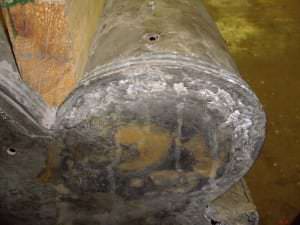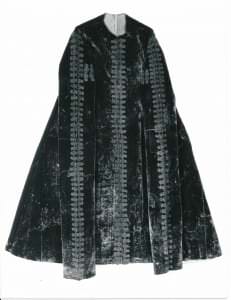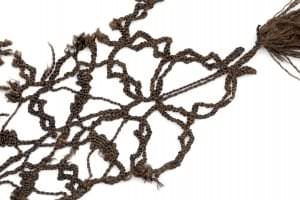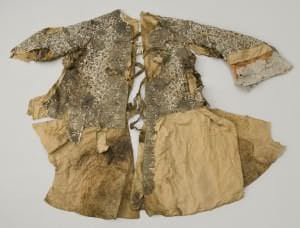Putting the ducal vault in order and creation of the exhibition is going on for more than thirty years. It comprises a complicated and time-consuming process – preservation and restoration of sarcophagi, coffins and textiles.
At the moment restoration of 13 sarcophagi is completed. The restoration process includes research of the historical materials, selection of appropriate technologies, technical restoration, reconstruction of missing parts, cleaning of metal surfaces.





Financially the restoration of the sarcophagi was supported by the United Foundation of Courland Knighthood, Baron Nicolas von Behr, Dr. Rüdiger Zellentin, members of Biron family and State Culture Capital Foundation.


Textiles is a unique testimony of the applied materials, techniques of dressmaking, embroidery, knitting and other techniques and the fashionable couture trends in the Duchy of Courland in the 17th and 18th centuries. Because the vault of the dukes of Courland has not only been subject to natural processes of decay but also to human evil and greed, in 1973 the textiles were in a deplorable condition. They were taken to Rundāle Palace for cleaning and protection from further deterioration. By 1980 most of the materials were cleaned and research and restoration could be started.

Duke Wilhelm’s (1574-1640) gown
Duke Wilhelm’s clothing consists of a dark brown silk waistcoat, breeches and hat, dark brown velvet coat with long sleeves and knitted silk stockings. The gown is adorned with silk tatted rosettes and cone-shaped buttons. The collar of the waistcoat is adorned by a stitched geometric patterned lace with a serrated hem and is characteristic to the 1st half of the 17th century.
The coat was restored by senior master Daira Līdaka from 1980 to 1983. Being an excellent model, it was exhibited in Latvia and abroad and now it is displayed at the vault exhibition.





The waistcoat and breeches were restored by senior master Daira Līdaka.



Duchess Louise Charlotte’s (1617-1676) gown
The dress is made of golden-orange silk brocade with a baroque pattern of leaves and flowers. It is adorned with 8 cm wide silver brocade lace ribbons. Because there were still silver oxide marks on the fabric, it was possible to sew the lace accurately in its original place.


Princess Christine Sophie’s (1649-1650) gown
The light patterned silk dress with silver brocade lace was restored by senior master Maruta Tālante. In 1990 the gown was exhibited at the Baltic conference of restorers in Tallinn, currently it can be seen at the exhibition of the ducal vault of Courland.


To replace the lost lace, it was necessary to decipher the lace pattern. The lace-making roller pillow and bobbins were made by restorer of furniture Vilnis Līdaka. The yarn was cabled from jade coloured and yellow threads, which visually look like old blackish brocade threads. The length of the reconstructed lace is 3.2 metres and it was sewn in places where the original lace was lost.



Duke Friedrich Casimir’s (1650-1698) gown
The Duke’s gown was described in detail by his valet Johann Casimir Brandt: “His majesty’s body was dressed in a very luxurious gold and silver waistcoat, on top of which was an ornate, white coat, embroidered with gold. Both the waistcoat and the coat had expensive diamond buttons…” On top of that was a red velvet robe with silver brocade lining. The gown is partly preserved, restored and displayed at the vault exhibition. However, the statement about diamond buttons seems doubtful, since Dr. A. Raphael after the research of the burial in 1913 noted that the buttons of the waistcoat and breeches were covered with brocade. Two different kinds of buttons made of brocade threads have survived. It has not yet been found how they were made.



During the scientific research in 1934 Duke Friedrich Casimir’s coat, which is an exceptionally beautiful and valuable sample of gold embroidery, was taken out of the burial. It was kept at the National History Museum of Latvia, and then loaned to the Rundāle Palace Museum. The coat was restored by senior masters Daira Līdaka.

The restorer says, “It is not known when the front of the coat was cut. Since A. Raphael does not mention this fact, it has probably happened in 1919 when the vault was ravaged by Bermontians. According to the basic principles of restoration, the missing part could be replaced by a similarly tinted fabric, but I wanted to create a complete picture of the gorgeous costume. I thought – maybe it is possible to create a computer program of embroidery pattern. This complicated task was assumed by Līga Ķerve. I had to deal with another problem – the modern wool fabrics are very different from those made in the 17th century. Once in a store I noticed wool for felting in exactly the desired tone. Wet felting technique was used to make fabric suitable for embroidery. ”



27.07.2018
